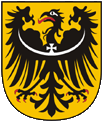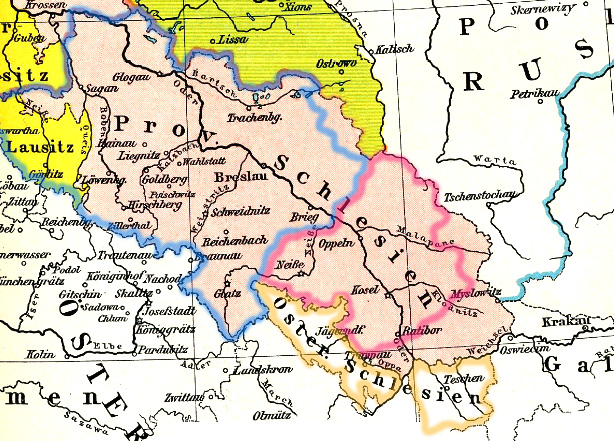

Silesia was initially Austrian and later Prussian, but it never used the Austrian or Prussian colors. The colors white and gold have their roots in the coat of arms. From 1875, the provinces of Prussia could largely operate in self-governing. There was a provincial parliament and a provincial government (Provincial Committee). Each province had its own colors (Landesfarben), which were also used as flag, and they had also their own coat of arms. If the provincial governments put for official purposes (official flag) their coats of arms on a flag with the provincial colors is not handed down beyond doubt and not for all provinces.
Source: Wikipedia (D),
Volker Preuß


16th cent.,
Coat of Arms of Duchy of Silesia-Sagan,
Source, by: Wikipedia (D)

1890–1919,
Coat of arms of Silesia,
Source, by: Wikipedia (D)

The Duchy of Silesia belonged from the 12th century under the Polish Piast dynasty, however, very quickly it splintered into many several duchies. These subordinated themselves voluntarily as fiefdom under the Bohemian Crown in the 14th century, so that Silesia became part of the Holy Roman Empire of German Nation. In the 16th century the Bohemian Crown came to the House of Habsburg. The last Silesian Duke of Liegnitz died in 1675, Prussia rises claims, culminating in the for Prussia victorious Silesian Wars (1742-1763). Habsburg had to cede Silesia to Prussia, except some small areas, that remained as Crown Land of Austrian Silesia at the Empire of Austria.
The coat of arms of the old Duchy of Silesia showed a golden shield, a black eagle on it, and on his breast a silvery moon. It goes back to Heinrich V. of Silesia, who became in the 13th century the Duke of Jauer, Liegnitz and Breslau. In this way the eagle was later transferred to the Duchy of Sagan, however, the silvery moon on the breast of the eagle became supplemented with a middle to upwards moved silvery cross. In 1813, Prussia abolished the individual duchies, and the country became a province, and its coat of arms became the eagle-shield.
The coat of arms of the Prussian Province of Silesia shows the gold shield with the black eagle with the red armor and the silver moon with the in the middle upwards moved silvery cross. The eagle in the coat of arms weared initially no special crown, but from 1864 a ducal crown, and from 1890 a princely hut. Over the coat of arms is placed a ducal crown. Austrian Silesia used the same coat of arms, but the silvery moon ends at left and on right in clover stems.
In 1918 the monarchy in Prussia was overthrown, and in 1919 Silesia was divided into Upper Silesia and Lower Silesia. Lower Silesia took over the crest of Silesia, Upper Silesia got a new coat of arms in 1926. Both arms bear no ducal crown anymore, but, as usual in the Republic, the so-called people's crown.
Source:
Wikipedia (D)


Source:
F. W. Putzgers Historischer Schul-Atlas, modyfied by: Volker Preuß
The historical map shows Prussian Silesia between 1806 and 1815 as bright red area. The yellow areas in the Northeast have been ceded by Saxony to Prussia in 1815 and became connected to Silesia. Austrian Silesia (1742-1918) appears in a dark yellow outline. In the year 1919 Prussian Silesia became divided into two provinces, Upper Silesia (bright red outline) and Lower Silesia (bright blue outline)

Area: 14.021 square miles (1885)
Inhabitants: 4.112.000 (1885)
Density of Population: 264 inh./sq.mi. (1885)
Capital: Breslau, 295.300 inh. (1884)
Source: Meyers Konversationslexikon

ca. A.D. · settlement by the teutonic tribe of the Lugier
2nd and 3rd cent. · settlement by the teutonic tribes of the Burgunders und Vandals
ca. 300 · settlement by Slavic tribes
1137 · Silesia comes from Bohemia to the Polish Piast dynasty, division into many duchies
1163 · establish of the Silesian Duchies of Breslau and Ratibor
1241 · Mongol Invasion, 80% of the inhabitants of Silesia are killed, the loss becomes compensated by planned colonization by Germans
1289 · the first Silesian Duchy (Cosel-Beuthen) subordinates itself voluntarily as fiefdom under the Bohemian crown (House of Luxembourg), to 1342 follow all the other duchies
1335 · Polish King Casimir III. waives all claims in Silesia
1348 · King Karl IV. of Bohemia incorporates the Silesian duchies in the Bohemian Crown, thus they become part of the Holy Roman Empire of German Nation
1526 · death of the Bohemian King Ludwig II. in the Battle of Mohács, the legacy of the Luxemburgs goes to the House of Habsburg (Austria), the Habsburgs become in this way Kings of Bohemia and Dukes of Silesia
1675 · death of the last Piast duke, Georg Wilhelm of Liegnitz, the Electorate of Brandenburg lays claim to the duchies of Georg Wilhelm, Prussia under Friedrich II. extends the claims over whole Silesia
1740–1742 · First Silesian War (Prussia against Habsburg)
1742 · because of the victory of Prussia over Habsburg comes Lower Silesia, a large part of Upper Silesia and the County of Glatz to Prussia, small areas of Silesia around Troppau, Jaegerndorf, Teschen und Bielitz remain until 1918 as Crown Land of Austrian Silesia in the Austrian Empire
1813 · Prussia abolishes the several duchies and forms out of them it the Province of Silesia
1815 · annexation of the from the Kingdom of Saxony ceded Upper Lausitz
1919 · the governmental District of Oppeln is declared to the Province of Upper Silesia and the Governmental Districts of Breslau and Liegnitz is declared to the Province of Lower Silesia
1922 · ceding of East Upper Silesia to Poland, and of the Hultschin Land (Hlučín Region) to Czechoslovakia
1938 · merge of the Provinces of Upper Silesia and Lower Silesia to the Province of Silesia, re-affiliation of the Hultschin Land (Hlučín Region)
1939 · re-affiliation of East Upper Silesia, further little enlargement of territory
1941 · the Governmental Districts Oppeln/Kattowitz resp. Breslau/Liegnitz get declared to the Provinces Upper Silesia and Lower Silesia
1945 · Soviet conquest and Polish occupation of Sielsia eastern the Neisse River, affiliation of Silesia western the Neisse River to the Country of Saxony, expulsion of 3,5 million German inhabitants out of the Polish occupied territories, annexation of the Olsa Region and the Hultschin Land (Hlučín Region) by Czechoslovakia
Source:
Wikipedia (D),
Schwarzbuch der Vertreibung

The name of the country goes back to the Vandal tribe of the Silings, who settled here in the second and third century. Also the Sleza River (German: Lohe) – an affluent of the Oder River – counts as source of the name of the country Silesia.
Source: Handbuch der geographischen Namen







Preußische Allgemeine Zeitung
Die Fundgrube für Geschichtsbegeisterte. Mit sehr großem kostenlosen Archiv mit den kompletten Ausgaben dieser Zeitung mit sehr interessanten Artikeln über die preußische Geschichte.

![]()








